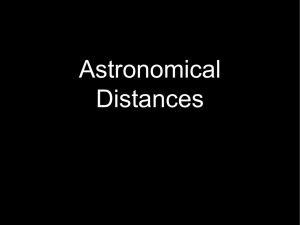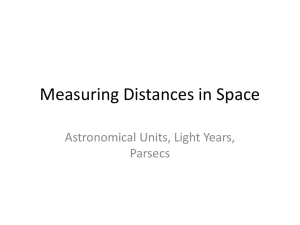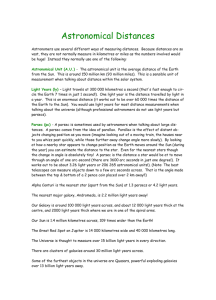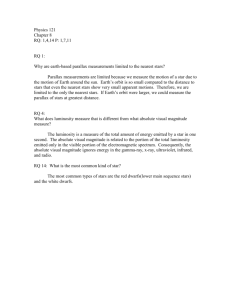MEASURING DISTANCE TO THE STARS
advertisement
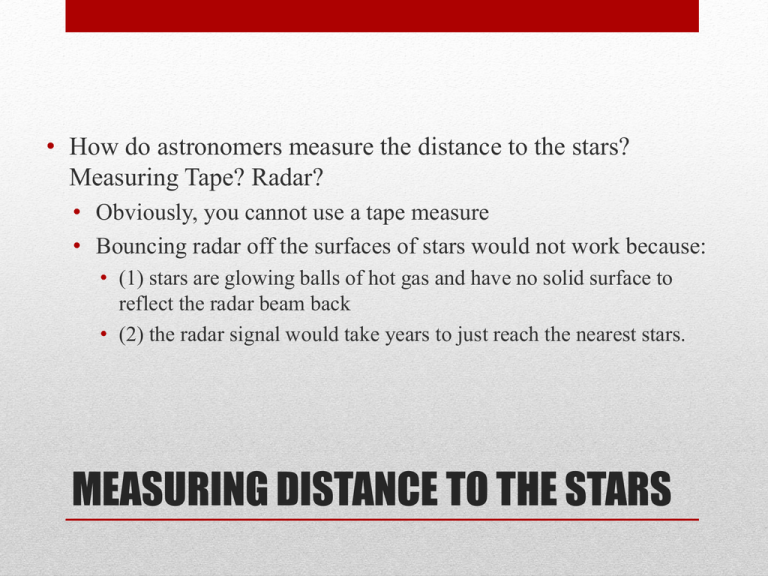
• How do astronomers measure the distance to the stars? Measuring Tape? Radar? • Obviously, you cannot use a tape measure • Bouncing radar off the surfaces of stars would not work because: • (1) stars are glowing balls of hot gas and have no solid surface to reflect the radar beam back • (2) the radar signal would take years to just reach the nearest stars. MEASURING DISTANCE TO THE STARS • A favorite way to measure great distances is a technique used for thousands of years: • look at something from two different vantage points and determine its distance using trigonometry. • The object appears to shift positions compared to the far off background when you look at it from two different vantage points. • The angular shift, called the parallax, is one angle of a triangle and the distance between the two vantage points is one side of the triangle. • Basic trigonometric relations between the lengths of the sides of a triangle and its angles are used to calculate the lengths of all of the sides of the triangle. PARALLAX • The size of the parallax angle p is proportional to the size of the baseline. • If the parallax angle is too small to measure because the object is so far away, then the surveyors have to increase their distance from each other • Ordinarily, you would use tangent or sine, but if the angle is small enough, you find a very simple relation between the parallax angle p, baseline B, and the distance d: p = (206,265 × B)/d PARALLAX CONTINUED • Trigonometric parallax is used to measure the distances of the nearby stars. • The stars are so far away that observing a star from opposite sides of the Earth would produce a parallax angle much, much too small to detect. • As large a baseline as possible must be used. The largest one that can be easily used is the orbit of the Earth. In this case the baseline = the distance between the Earth and the Sun---an astronomical unit (AU) or 149.6 million kilometers! • A picture of a nearby star is taken against the background of stars from opposite sides of the Earth's orbit (six months apart). • The parallax angle p is one-half of the total angular shift. EARTH’S ORBIT AS BASELINE • The distances to the stars in astronomical units are huge, so a more convenient unit of distance called a parsec is used (abbreviated with ``pc''). • A parsec is the distance of a star that has a parallax of one arc second using a baseline of 1 astronomical unit. 1 parsec = 206,265 astronomical units = 3.26 light years • FYI: The nearest star is about 1.3 parsecs from the solar system. • Using a parsec for the distance unit and an arc second for the angle, our simple angle formula above becomes extremely simple for measurements from Earth: p = 1/d THE PARSEC • The angles involved are very small, typically less than 1 second or arc! (Remember that 1 arc_second = 1/3600 of a degree). • To determine the distance to a star we can approximate the equation given in the previous section with the small angle approximation: d=r/p • where d is the distance to the star, p is the parallax angle expressed in radians (see diagram), and r is the baseline, in this case 1 Astronomical Unit (A.U.) -- the radius of the Earth's orbit. Since there are 206,265 arc-seconds per radian, the formula can be re-written as: d (in AU) = 206,265 / p • with p measured in arc-seconds . Or • If we define the distance of one parsec as 206,265 AU, we get: d (in parsecs) = 1 / p • This is the distance unit astronomers use most frequently, and it is equivalent to 3.26 light-years. ONE MORE TIME • Parallax angles as small as 1/50 arc second can be measured from the surface of the Earth. • This means distances from the ground can be determined for stars that are up to 50 parsecs away. • If a star is further away than that, its parallax angle p is too small to measure and you have to use more indirect methods to determine its distance. • Stars are about a parsec apart from each other on average, so the method of trigonometric parallax works for just a few thousand nearby stars. PARALLAX ONLY GOOD FOR NEARBY STARS • When the direct method of trigonometric parallax does not work for a star because it is too far away, an indirect method called the Inverse Square Law of Light Brightness is used. • This method uses the fact that a given star will grow dimmer in a predictable way as the distance between you and the star increases. • If you know how much energy the star emits, then you can derive how far away it must be to appear as dim as it does. • A star's apparent brightness (its flux) decreases with the square of the distance. • The flux is the amount of energy reaching each square centimeter of a detector every second. • Energy from any light source radiates out in a radial direction so concentric spheres (centered on the light source) have the same amount of energy pass through them every second. • As light moves outward it spreads out to pass through each square centimeter of those spheres. DISTANCE-INVERSE SQUARE LAW The same total amount of energy must pass through each sphere surface. • Since a sphere has a surface area of 4𝜋𝑟 2 : • the flux on sphere-1 = (the flux on sphere #2) × [(sphere #2's radius)/(sphere #1's radius)]2.

